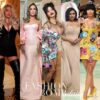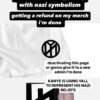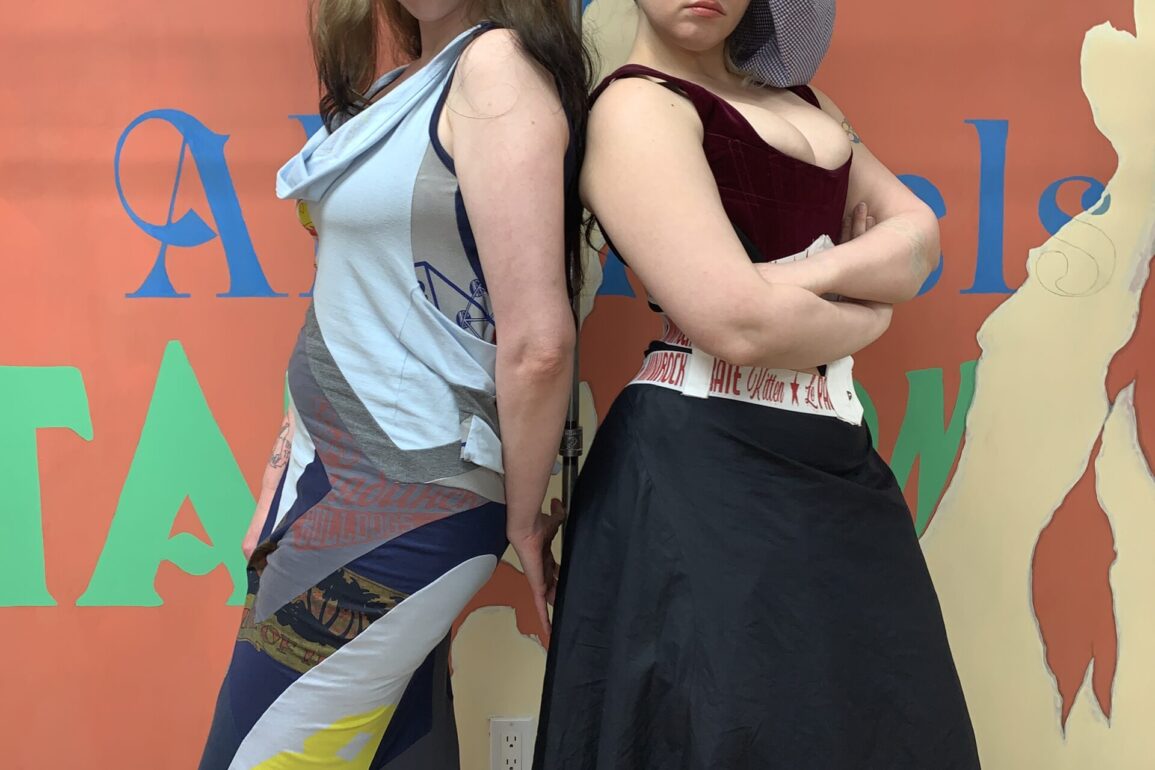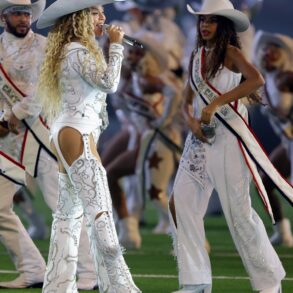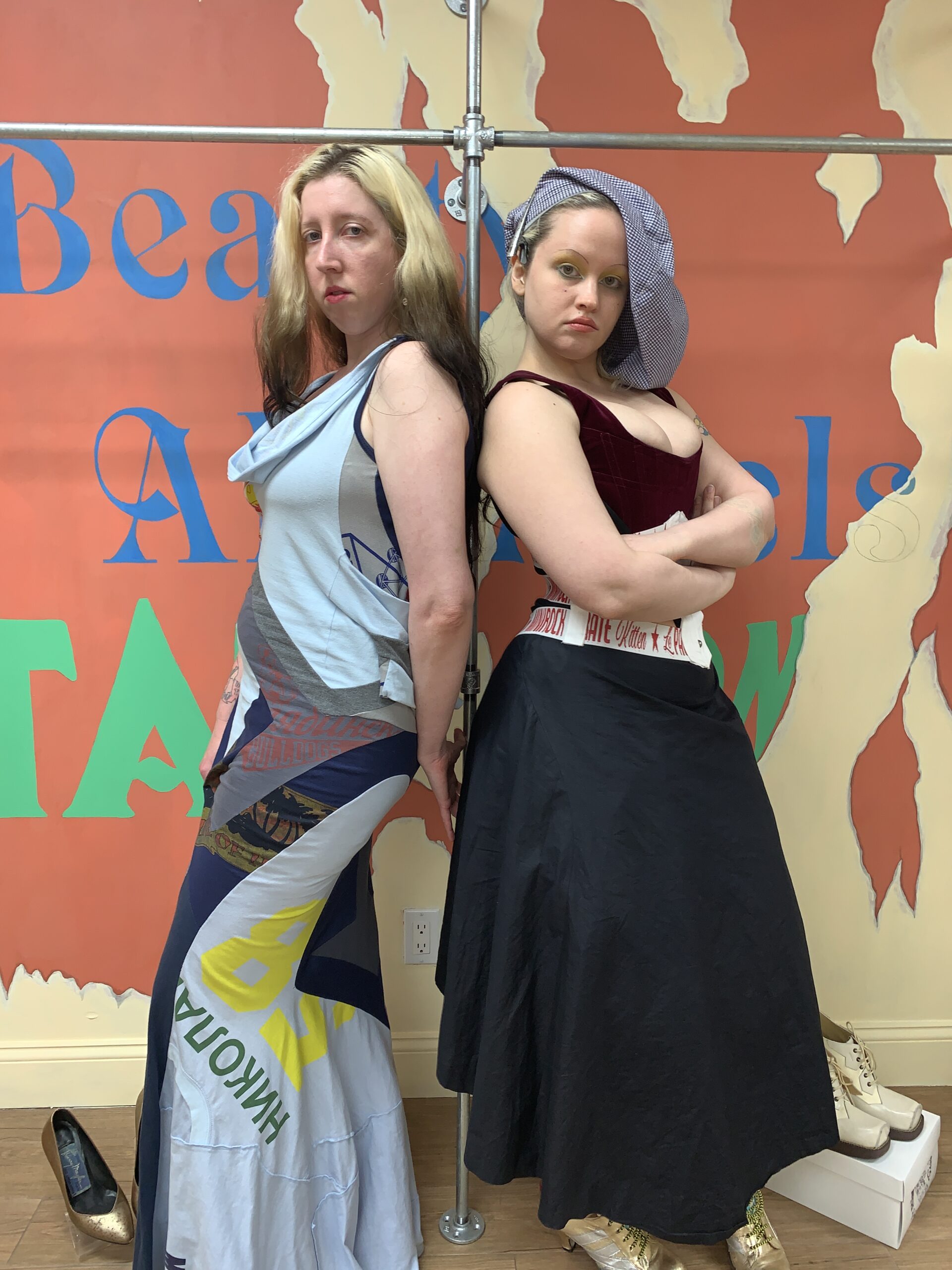
The duo behind Women’s History Museum Vintage. From left to right: Amanda McGowan, Mattie Barringer.
Shopaholics rejoice, brick and mortar is back. If the fanfare around the reopening of Century 21 earlier this year was a sign, it’s that New Yorkers are desperately in search of well-stocked shelves to peruse. To investigate the retail renaissance, or lack thereof, Interview Senior Editor Taylore Scarabelli takes us on a spree to discover the best shopping in the city. First stop: Women’s History Museum Vintage on Canal Street, a second floor store where Mattie Barringer and Amanda McGowan (founders of the WHM fashion and art collective) hawk everything from Vivienne Westwood to obscure Japanese brands, as well as their own namesake label. While Taylore hunts for a party look, the duo tell her about their Blogspot beginnings, Catholic school fashion, and their biggest grails.—MEKALA RAJAGOPAL
———
TAYLORE SCARABELLI: How long have you been open now?
MATTIE BARRINGER: Five weeks, maybe?
SCARABELLI: Do you get any randoms off the street going, “What’s Women’s History Museum?”
BARRINGER: We do.
AMANDA MCGOWAN: They’re like, “Is this the museum?”
SCARABELLI: [Laughs] I have to try out this pink Chantal Thomass suit.
BARRINGER: That would look so cute on you with your hair. Professional girl.
MCGOWAN: I’ll start a fitting room for you.
SCARABELLI: Also, I need something to wear to Club Glam tonight. Maybe this top that says, “Glamorous, sexy, material girl.”
MCGOWAN: It says it all. But yeah, it’s kind of inconsistent when people come to the store.
SCARABELLI: I think you should start working with the women selling fakes outside. Maybe you could pay them to put up a little sign up. “Shop designer vintage at Women’s History Museum.”
BARRINGER: That could be cool.
SCARABELLI: And then maybe you could low-key sling a couple bags for them.
MCGOWAN: Why not?
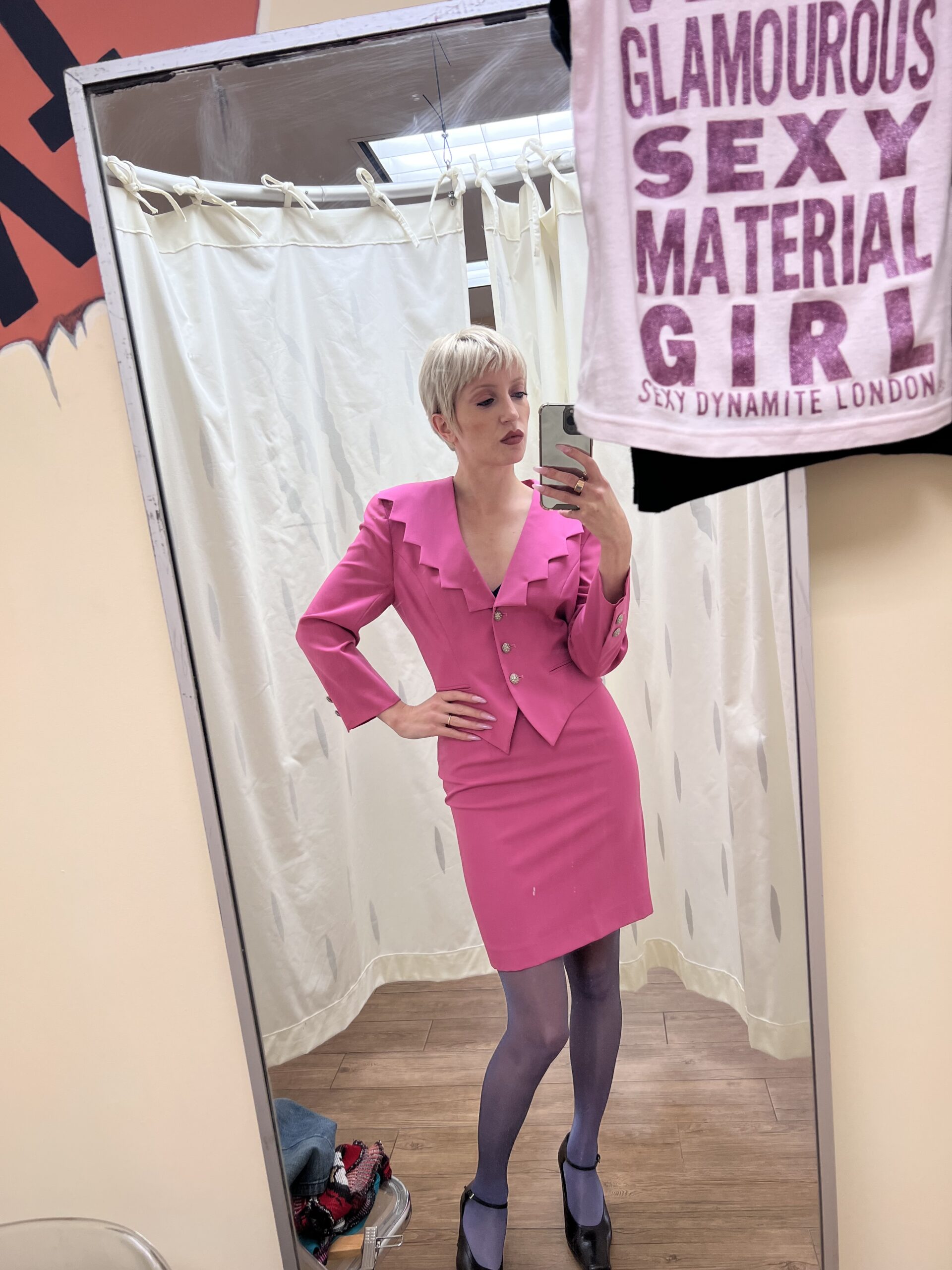
SCARABELLI: So how did you guys meet? When did you start collabing?
MCGOWAN: We met in 2011, but we started our line in 2015?
BARRINGER: Uh huh.
MCGOWAN: We initially wanted to make a magazine.
SCARABELLI: Really?
MCGOWAN: Yeah. We took a magazine class together in college.
BARRINGER: It was so weird.
MCGOWAN: Yeah. It just seemed like there was a lot of overhead. Then, when we graduated, we needed to get our shit together for a few years before we actually started making work.
SCARABELLI: So what was the original idea with the clothes?
MCGOWAN: We were just always obsessed. We actually had a fashion blog back in the day.
MCGOWAN: A Blogspot.
SCARABELLI: What was it called?
BARRINGER: It can’t be revealed. But it’s honestly not that bad in retrospect.
MCGOWAN: It’s not that bad, but it’s still just like—it needs to stay in the vault.
SCARABELLI: [Laughs] Fair. It seems vintage clothing is a big inspiration to you guys as designers and artists in a very literal way. You’ve even made dresses out of old designer bags. And by bags, I mean shopping bags.
BARRINGER: Yeah. We were always into collage and cutting up magazines. We wanted to make our own fashion world and didn’t see anything that really reflected that. And then our friend Donna Huanca was doing an art show and she gave us the front of her studio to make clothing. She was like, “You can make clothes for the performers.”
MCGOWAN: But we never made anything. She never saw anything. [Laughs]
SCARABELLI: Did you know how to sew?
BARRINGER: We’re completely self-taught, we didn’t go to fashion school or anything.
MCGOWAN: You had some experience.
BARRINGER: I grew up Mormon, so we were forced to learn how to sew.
MCGOWAN: I did a lot of hand sewing in high school. I would make some of my own clothes.
SCARABELLI: You were more punk.
MCGOWAN: It was definitely very DIY. So, in terms of construction and things like that, I had no experience with pattern making.
BARRINGER: Me either.
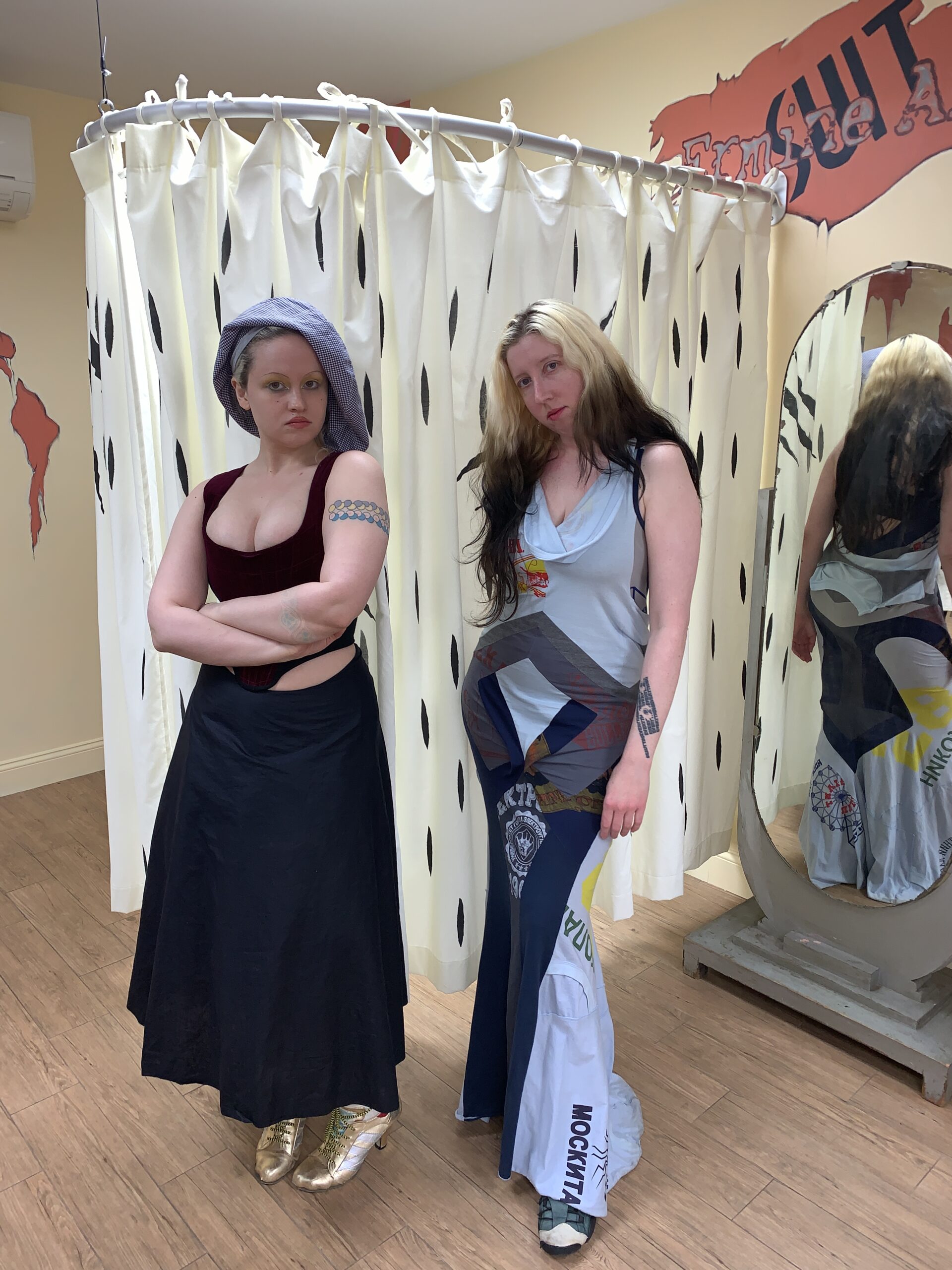
MCGOWAN: We were living at my mom’s house in the Bronx and she had a basement and we were like, “We’re going to make it into a studio.” And it was so depressing and freaky in there. We never did anything. I’ve realized over time we really need an aesthetic environment to be productive.
BARRINGER: We’re bedroom artists.
SCARABELLI: But you were always collecting vintage?
MCGOWAN: Definitely. And Mattie worked at Beacons [Closet] in the golden era. When they actually had good stuff.
SCARABELLI: Mattie, you were saying you grew up Mormon, where are you from?
BARRINGER: I grew up in Virginia and then Las Vegas and then Virginia again.
SCARABELLI: Okay.
BARRINGER: My mom and my grandmother were really into clothes, but in a conservative way. They’re not typical Mormon looking, but—
SCARABELLI: They were modest.
BARRINGER: Yeah, you have to be.
MCGOWAN: Mattie’s mom is really into Comme des Garçons. She’ll wear it to church.
BARRINGER: But now she’s kind of goth, she wears all black and she looks a little bit Hasidic.
SCARABELLI: Wow. Would she ever model for you guys?
BARRINGER: No, she’s too nervous.
MCGOWAN: Mattie’s grandma is also insane goals. She’s stunning and has amazing style. My family is not fashionable at all. We come from totally different backgrounds but have a very common aesthetic language. But in high school, I was obsessed with Teen Vogue and that was probably my entry point to anything fashion related.
SCARABELLI: Were you guys on Tumblr?
MCGOWAN: In college.
SCARABELLI: What was your style back then?
MCGOWAN: We both really liked Grimes and stuff, cause it was, like, 2011.
BARRINGER: A lot of Opening Ceremony. Our first friend date ever was going to the Opening Ceremony sale.
SCARABELLI: It’s like that thing when you see someone and you’re like, “They’re kind of dressed like me, I can’t tell if we’re going to be enemies or besties.”
MCGOWAN: We were definitely besties from the start. It was very, “We need to be friends.”
BARRINGER: Definitely. I remember Amanda came up to me and complimented something I was wearing, and she had a crazy coat on.
SCARABELLI: It was love at first fit.
MCGOWAN: [Laughs] Yeah. Your style in high school sounded really cool when you were into Amy Winehouse and everyone thought you were a drug addict, but you weren’t.
SCARABELLI: Did you have her hair?
BARRINGER: I did the Posh Spice.
MCGOWAN: It was a little Ronettes or something.
BARRINGER: Posh Spice when she had that short angled cut, but then I was growing it out and would do a little bouffant thing.
MCGOWAN: It looked really cool.
SCARABELLI: Were you blonde then?
BARRINGER: Not like this. I wasn’t allowed to go this blonde.
SCARABELLI: Now your hair is more Pamela Anderson. Were you supposed to be modest?
BARRINGER: Yeah, I was pretty policed, I would say maybe not as much as some of my friends—
SCARABELLI: So your family inspired you, but they also inspired you to rebel?
BARRINGER: Exactly.
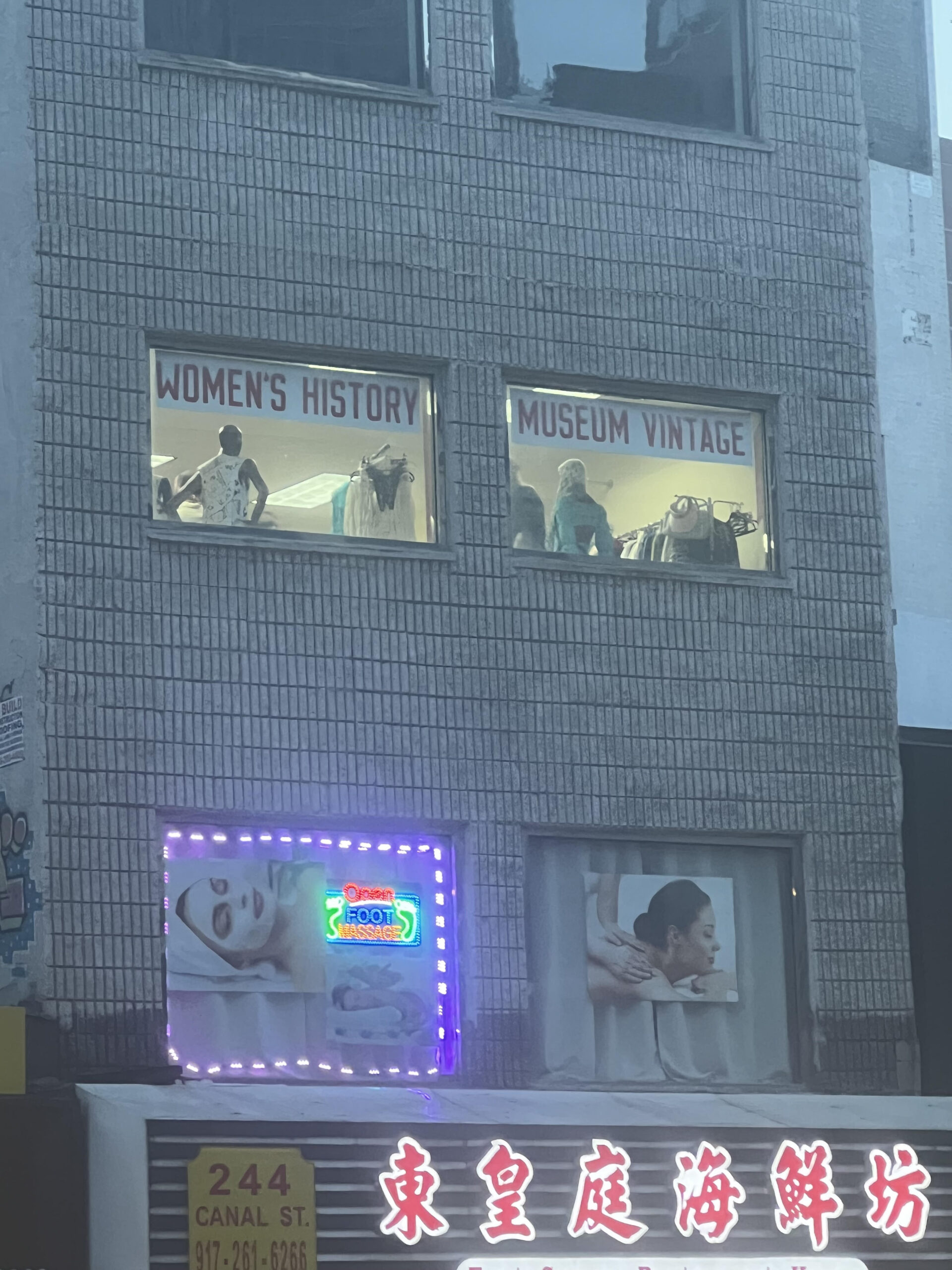
SCARABELLI: [Lifts a blue sequin top off the rack] Biba, whoa.
BARRINGER: Yeah, that used to be mine.
MCGOWAN: It’s crazy. Also, the tag.
BARRINGER: That color would look great on you.
MCGOWAN: I was going to say, I’m thinking of the group photo that they retouched your cleavage in—what’s it called?
BARRINGER: It’s called seminary. You wake up and you go to Bible school before high school. So, you’re there at 5:00 AM doing scripture study and it’s literally hell. Right now I’m wearing a Vivian Westwood corset and my boobs are up here but back then, I was just wearing a normal outfit and I didn’t know I had cleavage in the photo. But basically my teacher announced in front of everybody that she had to Photoshop my cleavage out of the group photo.
SCARABELLI: Oh my god.
BARRINGER: I wasn’t dressing immodestly, I was dressing pretty conservative. But if you have a certain body type, you’re going to be policed.
SCARABELLI: It’s like, “I have breasts so therefore I am immodest.”
MCGOWAN: Yeah. And it’s either the gross men or the women that are thinking about the gross men, they’re going to be tempted by your body or whatever.
BARRINGER: It was always women policing me.
SCARABELLI: That’s how it works. [Goes into dressing room]
MCGOWAN: Yeah. I went to Catholic school and it was similar. Well we had a school uniform and everything was so strict. But Jennifer Lopez went to my high school—probably 20 years before me—and legend has it that she was the reason we were allowed to wear hoop earrings.
SCARABELLI: Oh wow. So you grew up in the Bronx.
MCGOWAN: Yeah. I remember on dress down days I would get in trouble. You couldn’t wear stuff that was ripped, which was my entire style at the time. So, I was just like, whatever, I’ll just get detention.
SCARABELLI: Anything to wear ripped jeans that are sort of sewn back together.
MCGOWAN: Exactly. I was such a goody goodie kid. And especially in high school, minus the constant clothing infractions.
SCARABELLI: That was your way of rebelling?
MCGOWAN: Definitely.
SCARABELLI: Do you consider yourselves extroverted or introverted? Sometimes I like to use clothing as a way to be loud when I don’t feel like saying anything.
MCGOWAN: I definitely relate to that. I was very introverted as a kid. So, I think that’s where it just all came from—style as a coping mechanism or protection or way of communicating. But now I feel like I’m more of an extrovert. But that took a lot of time and a lot of outfits.
BARRINGER: Yeah.
SCARABELLI: So who’s your ideal customer?
BARRINGER: Younger people are always so cute and fun to have in the store.
SCARABELLI: They’re like, “I’ve never seen a Biba piece in person,” or whatever.
MCGOWAN: Yeah.
BARRINGER: They’re so unbridled in their excitement for things. I feel like as you get older, you get a little more self serious. Usually when a group of young people come in it’s really cute and positive and uplifting.
SCARABELLI: [Comes out of the dressing room] Okay, I’m the bubble gum diva.
MCGOWAN: Oh my god.
BARRINGER: The skirt fits you like crazy.
SCARABELLI: The top is a little bit loose, but the skirt is insane.
MCGOWAN: The skirt would be really cute with a smaller top.
SCARABELLI: A bra?
MCGOWAN: Yeah, basically.
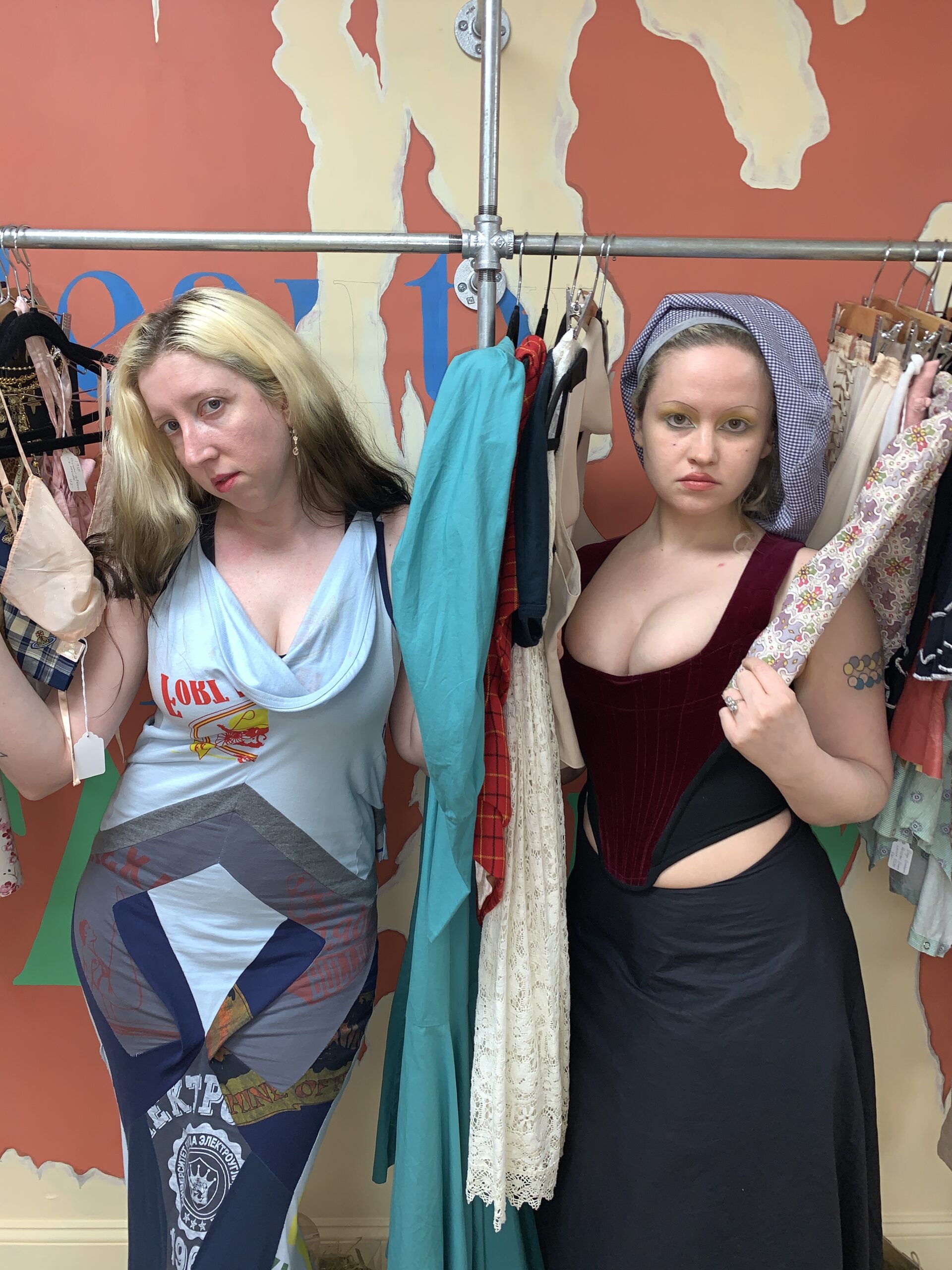
SCARABELLI: So, to use internet-speak , what are some of your biggest grails?
MCGOWAN: The thing hanging right next to you, Taylore, is crazy. It’s this 2047120 matching mini skirt.
BARRINGER: You can tie it into a bow in the back.
MCGOWAN: And then it’s like—
SCARABELLI: Matching leg warmers.
MCGOWAN: It’s from my personal closet. It was my favorite thing, but it doesn’t fit me anymore. I feel like that’s a brand that young people obsess over.
SCARABELLI: Give us a fashion history lesson.
MCGOWAN: It’s a Japanese brand from the nineties and early ’00s, they did really avant-garde shows and pieces and their stuff is super rare.
BARRINGER: Very rare. There were two designers [Lica and Masahiro Nakagawa], it was called Bellissima at first, and then they changed their name to 20471120—
SCARABELLI: Do you know why that number?
BARRINGER: There’s probably some mythology.
SCARABELLI: The date for the end of the world.
BARRINGER: Possibly. I feel like they’re so futuristic but also into historical stuff too, in a way that I feel like we’re aspiring to.
MCGOWAN: It’s very inspiring. And also, the physical stores they had in Tokyo were so cool. The architecture, the interior, just their commitment to their aesthetic was really inspiring.
SCARABELLI: Did that inspire your interior design at all? I mean, it looks crazy in here.
MCGOWAN: Thank you.
SCARABELLI: I love the mural on the walls. You were saying you guys did it yourself, right?
BARRINGER: Yeah. It took us a really long time.
SCARABELLI: What does it say? “Sex and beauty. All levels.” And that’s like, Vivienne Westwood font.
MCGOWAN: Yes.
BARRINGER: Which we love to use.

MCGOWAN: But apparently it is also used on a Britney Spears album.
SCARABELLI: Oh my god. True.
BARRINGER: We just kind of rambled off phrases back and forth to each other.
MCGOWAN: “Peace and orgasm.”
SCARABELLI: So “Ice Runway ’98?” That doesn’t mean anything?
MCGOWAN: No.
SCARABELLI: There’s definitely a nostalgic feeling in here. I don’t know what it is, but it feels cinematic almost.
MCGOWAN: Oh, thank you. It kind of reminds me of the stores in Tokyo or just in Japan in general.
BARRINGER: Just cause it’s on the second floor.
SCARABELLI: Do you guys go to Japan to source stuff?
MCGOWAN: We haven’t.
BARRINGER: Yet.
MCGOW: We’ve done in Paris and London sourcing together. Basically anytime we travel, we’re basically just like, okay, we’re going to bring or buy a suitcase and just buy a bunch of stuff. Which it’s fun because it’s less serious than our own [art practice]. The stakes feel so much lower, ’cause it’s just reselling clothes.
SCARABELLI: What brands are you usually looking for?
BARRINGER: There’s a handful of brands that we’re always looking for like Chantel Thomass, Vivienne Westwood, 20471120. But it runs the gamut. It can also just be if a piece is cool or we feel like there’s some kind of resonance with the stuff that we make.
BARRINGER: Aran keeps wondering what we’re doing. My partner has a store next door.
SCARABELLI: What’s it called?
BARRINGER: It’s called Charlot Abhors a Void.
SCARABELLI: Oh, okay.
BARRINGER: It’s like a very rolls-off-the-tongue kind of name.
SCARABELLI: Yeah. [Laughs]
MCGOWAN: Oh, someone’s coming in.
SCARABELLI: I better buy this suit before someone else does.

This post was originally published on this site be sure to check out more of their content.

